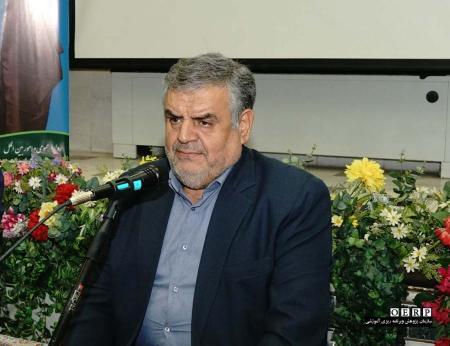
Stressing that the education and curriculum planning should be kept safe from two serious enemies, -obscenity and petrification-, Dr. Hassan Maleki stated that obscenity means not adhering to any principle and discipline, and petrification means ignoring the facts and scientific growth.
He added: We should not be neither fascinated nor hostile with different scientific views and schools; rather, we should be critical and selective.
“In curriculum planning process, when we get to any principle, we have to act on its curriculum. The term curriculum planning is mixed with all; so we can say objective-based curriculum design, content curriculum planning, evaluation curriculum planning, etc. Accordingly, when we want to choose the teaching method, the simplest and the most unscientific approach is to randomly choose a method from many. Especially, if we are fascinated by a particular school, we are tend to choose a teaching method suggested by that school. This is wrong. The right thing is to go through the steps of lesson planning and then choosing one appropriate method based on the requirements of effective training and learning, because every lesson planning has steps.”
“The teaching method should be dealt with like curriculum planning;” said Dr. Maleki. “Teaching method is not a piece of the curriculum and moreover, in selecting and organizing content, we must act according to just one method; in setting goals, we must consider optimal learning teaching strategies. For example, if we consider the inductive method for organizing the content, the teaching method cannot be deductive and vice versa.”
Dr. Maleki stressed that the method of organizing content limits the teaching methods. “In a way, when we organize content, we actually choose the method.”
“The third point is that the teaching method has a feature that other elements do not have: the connection between thoughts and actions. In other words, the feature that puts theory and decisions into actions and confronts the facts is the method.”
He added: “Basically, the teaching method reveals the nature of the decisions, it means that if we choose the teaching method correctly, this connection will be established well and vice versa.”
“Therefore, one can conclude in choosing the method, carful consideration is required and negligence should be avoided. The purpose is not to use existing teaching methods, but to use them consciously. Monotheistic naturalism requires step-by-step reflection, contemplation and vigilance, not blind obedience. We are looking to establish methods, not to copy them from others.
Dr. Maleki then announced the steps for determining teaching methods as follows:
1- Determining resources
2- Analysis of resources
3- Determining the general characteristics of teaching
4- Determining the special characteristics of teaching (specific to each field of education and learning)
The head of the Organization for Educational Research and Planning pointed out the resources needed to choose the method of teaching in monotheistic naturalism approach and classified them into four categories, adding that resources should be selected according to the monotheistic naturalism.
He called the first source as a methodological reference in the national curriculum that has the following characteristics:
* leading to the flourishing of fitrah;
* helping to understand and change phenomena, events and relationships;
* Exploring and trying to find answers to questions about phenomena
* The possibility of understanding and changing the general laws governing existence and cause-and-effect relationships
* The possibility to review the competencies acquired by the students
* Having opportunity to link between
• Opinions and actions
• Previous knowledge and experiences with new learning
• Different courses
* Utilizing active, creative and uplifting methods
* Leading to science creation
* The possibility of intelligent use of new educational technologies
Dr. Maleki called Quran as the second source in determining teaching methods and added: “The Qur'an is a book of guidance and education, but the design of educational topics in this divine book is different from the books written in the field of education.”
He noted the main features of educational methods in Qur'an as:
A) Being comprehensive: The generality of educational and moral issues is stated in a general and concise manner. The general lines are expressed in the Qur'an and its details are left to the tradition of the Prophet (PBUH) and the Ahl al-Bayt (AS) and human experiences.
B) Being interrelated: in each surah of Quran, many points are raised and noted; the issues and different topics are intertwined.
C) Being argumentative and persuasive: Qur'an, in many cases, has presented arguments by reasoning and describing the philosophy or the results so the audience are convinced.
In the approach of monotheistic naturalism, the method of teaching cannot be selected without considering the educational methods of Qur'an.
Dr. Maleki introduced "learning" in scientific texts as the third source in determining teaching methods and listed its characteristics as follows:
1-Lifelong learning and teaching features;
2-Personalization of learning and the role of the teacher;
3-Paying attention to the preschool years which are a very critical period;
4- Stressing life skills; as we have difficulty in communication skills and teamwork. Moreover, thinking skills are very important, our teaching methods should be thought-provoking.
5- New technologies and fast and easy learning;
6- A large amount of information and sources;
7- New social issues such as environment, health and...
8- Integrated learning is also an inevitable necessity;
9-Experimental learning (learning by doing)
10- Teachers’ full authority in the teaching-learning process: In this area, the question is what role and to what extent, the teacher should be given in monotheistic naturalism.
11-Ccontextual learning (making connection between learning and the surrounding environment).
He cited the fourth source as social, cultural and educational realities that have the following characteristics:
• Restrictive teaching facts
• Cultural diversity
• Differences in teachers' abilities
• Populated classes
• Multiple-level classes
• Unequal opportunities
• Diversity of methods
• Teachers’ authority in choosing methods
• Using social networks to exchange experiences
